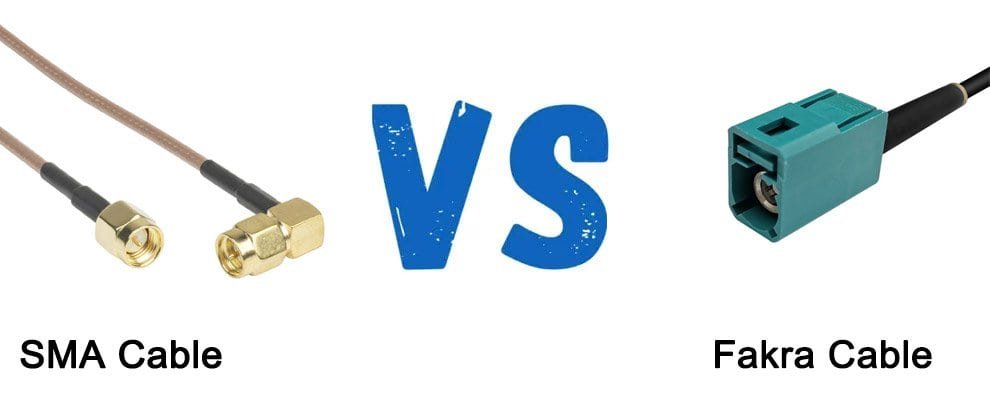In the realm of electronic connections, selecting the right connector is vital for ensuring performance and reliability. Two widely used options are SMA and Fakra connectors, each designed for distinct purposes. SMA connectors excel in high-frequency applications across multiple industries, while Fakra connectors, often paired with fakra cables, are engineered for automotive systems. This article addresses the problem of choosing between these connectors by analyzing their differences and providing solutions to help B-end users pick the right one for their needs.
Which Connector Should You Choose?
Businesses and engineers often face the challenge of selecting the appropriate connector for their specific applications. SMA and Fakra connector types may seem similar as RF signal transmitters, but their differences in design, functionality, and use cases can significantly impact system performance. Mischoosing can lead to connectivity issues, signal loss, or incompatibility. So, what sets them apart, and how do you decide?
Analyzing the Differences
What is an SMA Connector?
SMA (SubMiniature version A) connectors are compact, threaded coaxial connectors built for RF signal transmission. They support frequencies up to 18 GHz, making them a go-to choice for wireless communications, microwave systems, and test equipment. With a metal body and threaded locking system, SMA connectors ensure a stable connection, even in vibrating environments. They are versatile, available in male and female variants, and widely used in non-specialized RF applications.
What is a Fakra Connector?
Fakra connectors, derived from Fachkreis Automobil, are tailored for automotive applications. Based on the SMB design, they feature a plastic housing with color coding and mechanical keying to prevent mismating—crucial in vehicles with multiple connections like GPS, antennas, and multimedia systems. Fakra connectors handle frequencies up to 6 GHz and are built to endure harsh conditions, offering waterproof and dustproof properties.
Key Differences Between SMA and Fakra Connectors
- Purpose: SMA connectors are general-purpose, ideal for high-frequency needs across industries. Fakra connectors are automotive-specific, designed for vehicle environments.
- Design: SMA uses a metal, threaded structure for durability, while Fakra employs plastic housing with coding for error-free connections.
- Applications: SMA suits lab equipment and wireless networks; Fakra excels in automotive electronics like satellite antennas.
- Frequency: SMA reaches 18 GHz, whereas Fakra tops out at 6 GHz.
Solving the Problem: Choosing the Right Connector
Types of Fakra Cables and Their Applications
Understanding fakra cable variants helps in decision-making:
- Female to Female Fakra Cable: Connects two male Fakra ends, useful for extending connections.
- SMA to Fakra Cable: Links SMA and Fakra systems, bridging automotive and standard RF setups.
- Fakra Extension Cable: Extends reach in installations, maintaining signal quality.
- Fakra Coax Cable: Ensures RF transmission in automotive contexts.
- Fakra Coaxial Cable: Similar to coax, emphasizing signal integrity.
- Fakra Male to Male Cable: Less common, connects female Fakra ports.
- Fakra to SMA Cable: Interchangeable with SMA to Fakra, aiding compatibility.
These options cater to specific automotive needs, enhancing flexibility.
Factors to Consider
- Environment: Use Fakra connectors in automotive or rugged settings; opt for SMA in general RF scenarios.
- Frequency Needs: Choose SMA for frequencies above 6 GHz; Fakra suffices below that.
- Compatibility: Match connectors to your devices—e.g., use an SMA to Fakra cable for mixed systems.
- Usability: Fakra’s coding simplifies complex setups.
Practical Tips for Fakra Connector Installation
- Match color codes for accurate connections.
- Ensure a firm click to secure the fakra cable.
- Avoid bending cables sharply to preserve signals.
- Select sealed Fakra connectors for exposed areas.
Conclusion
Choosing between SMA and Fakra connectors boils down to your application. SMA connectors offer versatility and high-frequency performance for broad RF uses, while Fakra connectors, paired with fakra cables, provide specialized reliability for automotive systems. Whether you need a fakra extension cable for reach or an SMA to Fakra cable for integration, understanding these differences ensures efficient, reliable connections. Contact us for tailored solutions to meet your connectivity needs!

 Coaxial Cable Assembly
Coaxial Cable Assembly Microwave Test Cable
Microwave Test Cable Coaxial RF Connector
Coaxial RF Connector Coaxial RF Adapter
Coaxial RF Adapter Coaxial RF Termination
Coaxial RF Termination Coaxial RF Test Probe
Coaxial RF Test Probe Coaxial RF Attenuator
Coaxial RF Attenuator RF Switches
RF Switches Coaxial RF Power Dividers
Coaxial RF Power Dividers